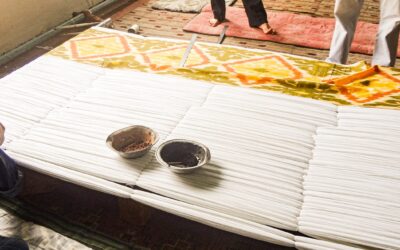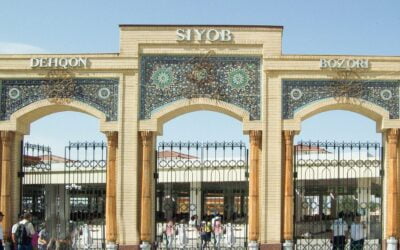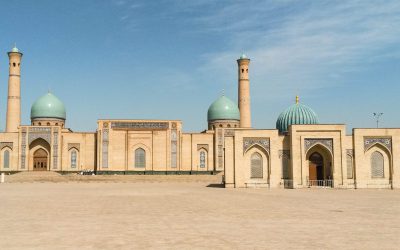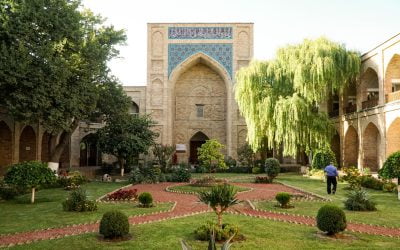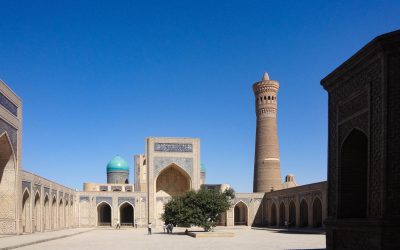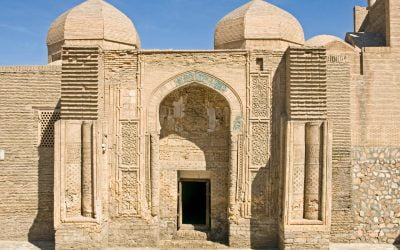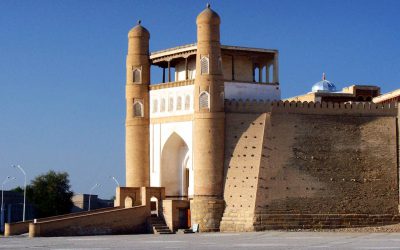KHIVA - ITCHAN KALA
Khiva is a 1 hour 30 minute flight west from Tashkent. One would fly to the nearby city of Urgench and then drive 30 minutes to the city of Khiva. Alternatively, the drive is about 14 hours from Tashkent and 6 hours from Bukhara. Itchan Kala (the Old City of Khiva) has been described as an ‘open air museum’ as all the monuments, musjids and madrasahs are in walking distance of each other.
HERITAGE SITE | KHIVA – ITCHAN KALA
-
- The ancient city of Khiva dates back to the 6th century CE, but was first recorded in the 10th century by Arab travelers. At the time, it was one of the major trading centers along the Silk Road. From dawn to dusk, camel caravans laden with goods would pass through its doors.
- In the 16th century it became the capital of the Khanate of Khiva and became known for its bustling slave market which lasted several centuries. In 1740, Nadir Shah of Persia invaded the region and made Khiva a part of the Persian Empire. Eventually, the Khanate of Khiva restored its order before they surrendered to the Soviets in 1924.
- Encircled by walls laid in the 10th century, Itchan Kala (Khiva’s Inner City) encloses buildings that date from the 12th century. Most of the palace buildings, musjids and madrasahs however date from 1780–1850, when the city prospered as a trade depot and fortress along the caravan routes that led across the Karakum Desert.
- Itchan Kala’s most astounding feature is how preserved it feels. Its mud-walled streets and courtyard homes seem barely touched by modern life and contain some of the best-preserved examples of Islamic architecture in Central Asia. It is a small city, but is the best-preserved stop on the 12 000 km stretch of the Silk Road.
- With over 50 historical sites in its tiny Old Town. The city is essentially an open-air museum that also resembles a sandcastle town with its clay-coloured houses and ancient minarets enclosed inside a gigantic fortress.
The Juma Musjid
- The beautiful Juma Musjid was built in the 10th century and rebuilt in 1788. As woodworking has long been a tradition in Khiva, nowhere in the city does this become more evident than at Juma Musjid — the most unique you’ll come across in Uzbekistan. The Musjids in this part of the world typically have portals, arched entrances, and domes. The Juma Musjid has none of these, but rather has a single hall with a flat ceiling which is supported by 215 wooden pillars. The pillars are exquisitely carved and display the different woodcarving styles found in Khiva throughout its history. Many of them are made from almond and elm trees around Khiva and date back to the 10th, 11th, and 14th centuries.
- There are three openings in the ceiling of the Musjid that allow the sun to cast an enchanting light between the pillars which adds to the Musjid’s serene, tranquil atmosphere.
- Sadly, this amazing Musjid isn’t in use today and is more of a museum for tourists.
Islam-Khoja Minaret
- At 57m tall, Islam Khoja Minaret is Uzbekistan’s highest minaret. Built in 1910 under the orders of Islam Khoja (the first vizier of the Khiva Khanate), this tower was used for the athan (call to the five daily prayers).
- Thanks to its impressive height, it also guided many travelers into the city from the surrounding Karakorum Desert. In terms of its design, decorative belts of blue and white ceramics alternating with ochre bricks adorn the minaret. It is topped by arched lantern and golden crown.
- Today, one may climb up its 118 steps to get a spectacular bird’s-eye view of Khiva and its 50 historical monuments. The morning and evening offer the best views. One should bear in mind however that the staircase is very steep and narrow.
- Next to the minaret is the Islam Khoja Madrasah, which consists of 42 hujras (rooms) and a large domed hall. Today, it houses the Museum of Applied Arts where handicrafts are sold.
Muhammad Rahim Khan Madrasah
- Muhammad Rahim-khan was be remembered as one of the enlightened and wise monarchs of the Kungrat dynasty and a patron of Islamic and other sciences. Being a poet himself, he introduced educational reforms and built a number of new schools.
- The Muhammad Rahim Khan Madrasah was erected in 1871 and became one of the largest in the territory of the Central Asia. Students were encouraged to study Islamic studies, poetry, mathematics, astronomy and geography and used to hold debates that the ruler himself used to take part in.
- As a structure, it was also pleasing to the eye and is a two-storey building with a high entrance portal. The yard has four iwans with four small turrets at the corners. There were 76 hujras (rooms) , a summer and winter Musjid and an extensive library.
- This madrasah is also not in use today.
Kalta Minor Minaret
- This beautiful turquoise-tiled minaret was built between 1851 and 1855 during the Khiva Khanate, under the rule of Mohammed Amin Khan. The khan had wanted to showcase the power of his Khanate and intended to build an 80m tall minaret that would surpass the famous Kalyan Minaret in Bukhara. He unfortunately wasn’t able to complete the task as he was killed in battle before the construction was completed. Kalta Minor Minaret was left unfinished at 29m and got its name which actually means ‘short minaret’.
- The gorgeous decorations on the minaret were the works of some of the best craftsmen in Khiva. Once it was clear that the minaret would remain unfinished, they sought to make the structure feel complete. The minaret therefore has the brightest and most colourful decorations in all of Central Asia.
Kunya-Ark
- Originally built in the 12th century, the Kunya-Ark is the heart of Itchan Kala, a town within a town and lies nestled against the western ramparts of the Old City. It was the fortress and Royal Residence of Khiva’s rulers after it was restored in the early 19th century. Like most other buildings in Khiva, the architecture is incredible.
- The palace has its own Summer Musjid with beautiful tile-work, its own mint, a throne room, a harem, stables, a prison and a large reception hall, which is decorated with even more amazing tile-work.
- A beautiful watchtower is linked to palace and offers a bird’s-eye view of the old and new cities of Khiva.
Pahlavon Mahmud Mausoleum
- The stunning mausoleum houses the tomb of Pahlavon Mahmud, one of Khiva’s biggest heroes and the city’s patron saint. Pahlavon Mahmud was a man of many talents; he was a poet, philosopher, and an accomplished wrestler all at once.
- He is said to have passed away in the 1320s and was buried in his workshop. Due to his piety, the people of Khiva built a mausoleum over his grave in the 1700s and decorated it with wonderful tile-work.
Statue of Muḥammad ibn Mūsā al-Khwārizmī
- The father of Algebra, al-Khwārizmī, hailed from this area of Khwārizm which is today known as the city of Urgench – about 30km’s from Khiva.
- Born in 780CE, the mathematician and astronomer is most well-known for his work Al-Kitāb al-mukhtaṣar fī ḥisāb al-jabr waʾl-muqābala (The Compendious Book on Calculation by Completion and Balancing) which was translated into Latin in the 12th century, from which the title and term algebra derives (al-jabr). The word algorithm is actually a Latinised version of his name.
- Another major work of his was Kitāb Ṣūrat al-Arḍ (The Image of the Earth) which has been translated as Geography. The work presented the coordinates of localities in the known world, based ultimately on those in the Geography of Ptolemy but with improved values for the length of the Mediterranean Sea and the location of cities in Asia and Africa. He also assisted in the construction of a world map for Caliph al-Maʾmūn and participated in a project to determine the circumference of the Earth, which had long been known to be spherical, by measuring the length of a degree of a meridian through the plain of Sinjār in Iraq.
- Today, a statue in Urgench reminds passers-by of the great intellectual who hailed from this area.


